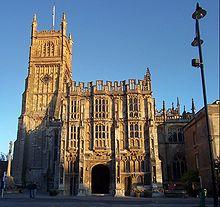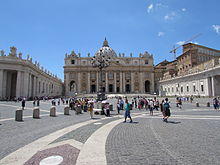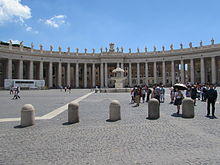A parvis or parvise is the open space in front of and around a cathedral or church,[1] especially when surrounded by either colonnades or porticoes, as at St. Peter's Basilica in Rome.[2] It is thus a church-specific type of forecourt, front yard or apron.
Etymology
The term derives via Old French from the Latin paradisus meaning "paradise".[3] This in turn came via Ancient Greek from the Indo-European Aryan languages of ancient Iran, where it meant a walled enclosure or garden precinct with heavenly flowers planted by the Clercs (Clerics).
Parvis of St Paul's Cathedral
In London in the Middle Ages the Serjeants-at-law practised at the parvis of St Paul's Cathedral, where clients could seek their counsel. In the 14th century Geoffrey Chaucer referred to "A sergeant of the laws ware and wise/ That often hadde yben at the paru[a]is...".[4] Later, ecclesiastical courts developed at Doctors' Commons on the same site.
- ^ that is, v (the letter "v" in its modern shape did not appear in the repertoire of most Middle English scribes
Late English use

In England the term was much later used to mean a room over the porch of a church. The architectural historians John Fleming, Hugh Honour and Nikolaus Pevsner,[1] and the theologians Frank Cross and Elizabeth Livingstone all say this usage is wrong. The Oxford English Dictionary records this use as being "historical", and current in the middle of the 19th century.[3] It may stem from an earlier misuse in F. Blomefield's book Norfolk, published in 1744.[2]
Examples of English parvises
The Parvise at Castle Ashby, Northamptonshire
Bletchingley Church Parvise, Surrey
The Parvise at Dodford Parish Church, Northamptonshire
The Parvise at Martham Parish Church, Norfolk
See also
- Church of the Holy Sepulchre
References
- ^ a b Fleming, Honour & Pevsner 1980, p. 238.
- ^ a b Cross & Livingstone 1997, p. 1224.
- ^ a b Brown 1993, p. 2112.
- ^ Chaucer: The Clerkes Tale, verse 8396.
Sources and further reading
- Brown, Lesley, ed. (1993) [1933]. The New Shorter Oxford English Dictionary on Historical Principles. II (3rd ed.). Oxford: Clarendon Press. p. 2112. ISBN 0-19-861134-X.
- Chaucer, Geoffrey. "The Clerkes Tale". The Canterbury Tales. verse 8396.
- Cross, F. L.; Livingstone, E, A., eds. (1997) [1957]. The Oxford Dictionary of the Christian Church (3rd ed.). Oxford University Press. p. 1224. ISBN 0-19-211655-X.
- Fleming, John; Honour, Hugh; Pevsner, Nikolaus (1980) [1966]. The Penguin Dictionary of Architecture. Harmondsworth: Penguin Books. p. 238. ISBN 0-14-051013-3.
- Hoad, TF, ed. (1996). The Concise Oxford Dictionary of English Etymology. Oxford University Press.
- Soanes, Catherine; Stevenson, Angus, eds. (2005). Oxford Dictionary of English (2nd, revised ed.). Oxford University Press.




